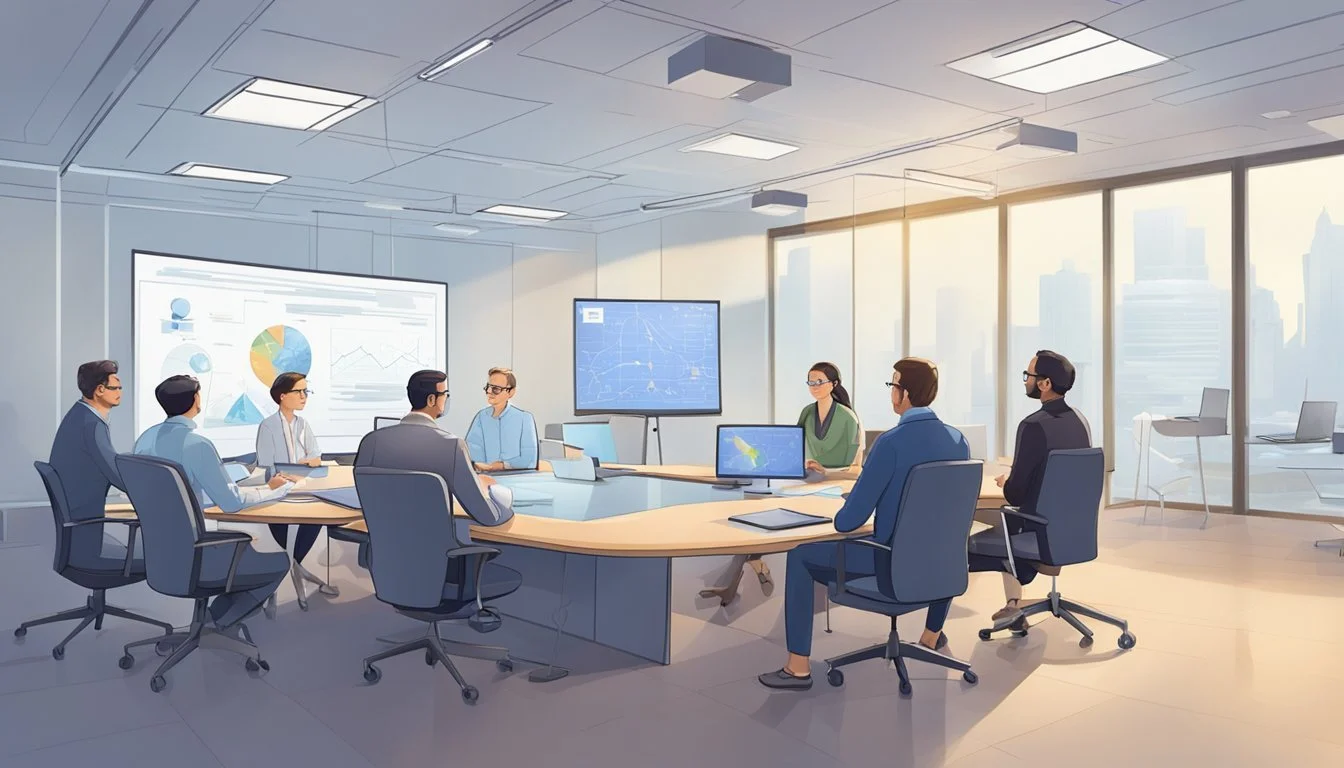Luis Elizondo Unveils Shocking UFO Information on CBS
Luis Elizondo, a former Pentagon insider and key figure in UFO investigations, recently appeared on CBS Mornings to discuss his new book "Imminent: Inside the Pentagon's Hunt for UFOs." As a former senior intelligence official, Elizondo offers unique insights into the secretive world of Unidentified Anomalous Phenomena (UAP) research conducted by the U.S. government.
Elizondo's book and CBS appearance shed light on the Pentagon's ongoing efforts to investigate and understand UAP sightings in restricted U.S. airspace. His work has helped bring mainstream attention to a topic long dismissed by many, sparking renewed interest in the possibility of extraterrestrial visitations.
The CBS Mornings interview provided a platform for Elizondo to share his experiences and expertise with a wide audience. His revelations about UFO encounters and the government's response have captivated viewers and readers alike, prompting serious discussions about national security implications and the potential existence of advanced technologies beyond current human understanding.
Who Is Luis Elizondo?
Luis Elizondo is a former U.S. intelligence officer who gained prominence for his work on unidentified aerial phenomena (UAP). He served as the director of a secretive Pentagon program investigating UAPs and has since become a vocal advocate for government transparency on the subject.
Career in Intelligence
Luis Elizondo spent over two decades working in various intelligence roles for the U.S. government. He served in the U.S. Army and later transitioned to counterintelligence operations. Elizondo's expertise included complex intelligence investigations and operations in hostile environments.
His background in intelligence analysis and field operations provided him with unique insights into national security matters. Elizondo's work often involved gathering and evaluating sensitive information from diverse sources.
Role in AATIP
In 2010, Elizondo became the director of the Advanced Aerospace Threat Identification Program (AATIP) at the Pentagon. This classified program was tasked with investigating unidentified aerial phenomena and their potential implications for national security.
Under Elizondo's leadership, AATIP collected and analyzed data on UAP encounters reported by military personnel. The program studied advanced aerospace technologies and their potential applications.
Elizondo resigned from the Pentagon in 2017, citing frustration with the lack of attention given to AATIP's findings. Since then, he has worked to bring public awareness to the UAP issue through media appearances and his book "Imminent: Inside the Pentagon's Hunt for UFOs."
The Pentagon's AATIP
The Advanced Aerospace Threat Identification Program (AATIP) was a secretive Pentagon initiative focused on investigating unidentified aerial phenomena. It operated from 2007 to 2012, though some claim its work continued unofficially beyond that timeframe.
Program Overview
AATIP was established to study unexplained aerial sightings and assess potential threats to national security. The program collected and analyzed data from military and civilian sources on UFO encounters. It produced detailed reports and briefings for government officials.
Luis Elizondo led AATIP in its later years. The program investigated numerous incidents involving unidentified objects demonstrating advanced technology. These cases often involved objects that displayed flight characteristics beyond known capabilities.
AATIP's work remained largely classified. Only a small number of officials were aware of its existence and findings during its official run.
Funding and Government Interest
AATIP received $22 million in funding over its 5-year lifespan. Senator Harry Reid of Nevada played a key role in securing this funding. He worked with other senators to allocate money for the program through the Defense Intelligence Agency.
The program's budget was relatively small compared to other defense initiatives. This limited funding reflected the controversial nature of UFO research within the government. Some officials supported AATIP's mission, while others were skeptical.
Congress showed renewed interest in the topic in recent years. This led to new requirements for the Pentagon to report on unidentified aerial phenomena. The military now openly acknowledges investigating such incidents.
A Spotlight on UAPs
Unidentified Aerial Phenomena (UAPs) have gained significant attention in recent years. Multiple credible incidents, military encounters, and advanced technology have brought these mysterious objects to the forefront of national security discussions.
Incidents and Sightings
UAP sightings have been reported by military personnel, pilots, and civilians alike. Many incidents involve objects exhibiting extraordinary flight characteristics beyond known human technology. These include rapid acceleration, hypersonic speeds, and seemingly defying the laws of physics.
The USS Nimitz encounter in 2004 stands out as a particularly notable case. Navy pilots observed a tic-tac shaped object performing impossible maneuvers off the coast of California. This incident sparked renewed interest in UAPs within military and intelligence communities.
Military Encounters
Military personnel have reported numerous UAP encounters during training exercises and operations. These sightings often involve objects detected visually and on radar simultaneously. Navy pilots have described UAPs as solid, physical craft capable of outmaneuvering advanced fighter jets.
Some encounters have raised concerns about potential safety risks to military aircraft. Reports indicate UAPs have approached dangerously close to military assets, prompting official investigations into their origins and capabilities.
Radar and Technology
Advanced radar systems and sensor technologies have played a crucial role in documenting UAP incidents. Multi-sensor data, including radar returns, infrared imaging, and electro-optical tracking, have provided compelling evidence of UAP presence.
The U.S. Navy has implemented new UAP reporting protocols and upgraded tracking systems to better capture and analyze these phenomena. Sophisticated sensor networks now allow for more accurate detection and measurement of UAP flight characteristics.
Ongoing efforts focus on enhancing data collection and analysis capabilities to gain a deeper understanding of UAP behavior and potential technological implications for national security.
CBS Coverage of UFO Phenomena
CBS News has extensively reported on unidentified aerial phenomena through its flagship programs. The network has featured interviews with key figures and in-depth investigations into UFO sightings and government programs.
60 Minutes Reports
60 Minutes aired a groundbreaking segment on UFOs in May 2021. The report included interviews with Navy pilots who described encounters with unexplained objects exhibiting advanced technology. Former government officials also spoke about the Pentagon's UFO investigation program.
The segment highlighted radar and video evidence of unidentified aerial phenomena. It explored the national security implications of these sightings and the government's evolving stance on UFO research.
Interviews and Discussions
CBS Mornings has featured several interviews with Luis Elizondo, former director of the Pentagon's Advanced Aerospace Threat Identification Program. Elizondo discussed his experiences investigating UFO reports for the government.
In these interviews, Elizondo shared insights on UFO sightings by military personnel. He emphasized the need for serious scientific inquiry into unidentified phenomena. CBS host Tony Dokoupil pressed Elizondo on the potential origins and implications of these sightings.
CBS News has also covered congressional hearings and government reports on UAPs. The network's reporting aims to present factual information on this complex and often controversial topic.
Government Secrecy and Opposition
Luis Elizondo encountered significant obstacles in his efforts to investigate UFOs for the Pentagon. He faced resistance from within the government and struggled against a culture of excessive secrecy surrounding the topic.
Transparency in UFO Research
Elizondo pushed for greater transparency in UFO investigations. He argued that classifying all UFO-related information hindered scientific progress and public understanding. The Pentagon's reluctance to share data frustrated researchers and impeded cross-agency collaboration.
Elizondo advocated for declassifying certain UFO reports and videos. He believed this would allow for more open scientific analysis. However, many officials opposed releasing sensitive information, citing national security concerns.
Challenges Within the Pentagon
Internal opposition hampered Elizondo's work at the Advanced Aerospace Threat Identification Program (AATIP). Some Pentagon leaders were skeptical of UFO research and viewed it as a distraction from other priorities. Elizondo faced bureaucratic hurdles in securing funding and resources for investigations.
The security review process often delayed or blocked the release of UFO-related materials. Elizondo argued this excessive secrecy was counterproductive. He believed it fueled conspiracy theories and prevented legitimate scientific inquiry. This conflict with Pentagon leadership ultimately led to Elizondo's resignation in 2017.
Global Perspective on UFOs
UFO sightings and investigations have become a global phenomenon, raising questions about international security and humanity's place in the cosmos. Countries worldwide are grappling with the implications of these unexplained aerial encounters.
International Cooperation and Concerns
Multiple nations have reported UFO sightings in their airspace, prompting increased international dialogue. The United States, Russia, China, and European countries have all documented unexplained aerial phenomena.
Some governments have established dedicated UFO research programs. France's GEIPAN and Brazil's UFO investigation unit are notable examples.
International security experts worry about potential threats posed by UFOs. The ability of these objects to enter restricted airspace undetected raises concerns about vulnerabilities in global defense systems.
Efforts to share UFO data across borders have increased. The United Nations has discussed the topic, though no formal international UFO investigation body exists yet.
Nonhuman Origin and Cosmic Implications
The possibility of UFOs having a nonhuman origin has profound implications for humanity's understanding of the universe. Scientists and researchers worldwide are considering the cosmic ramifications.
If UFOs are extraterrestrial, it would confirm that Earth is not the only planet harboring intelligent life. This revelation could reshape religious, philosophical, and scientific worldviews globally.
The advanced capabilities displayed by UFOs, such as hypersonic speeds and seemingly impossible maneuvers, suggest technology far beyond current human capabilities. This technological gap raises questions about cosmic civilizations and their potential influence on Earth.
Some researchers speculate about the motivations of potential extraterrestrial visitors. Theories range from scientific observation to resource exploration, sparking debates about cosmic ethics and interspecies relations.
Personal Accounts and Public Impact
Luis Elizondo's work on UFO investigations has sparked significant interest from both military personnel and the public. His revelations have brought attention to unexplained aerial phenomena and their potential implications for national security.
Witness Testimonies
Navy pilots have provided compelling accounts of UFO encounters during training missions. These firsthand reports describe objects with extraordinary capabilities, far beyond known human technology. Elizondo has shared these testimonies on various platforms, including CBS interviews.
Military intelligence officers have also come forward with their experiences. Their stories often involve radar data and other sensor information that corroborates visual sightings.
Elizondo frequently emphasizes the credibility of these witnesses. He points out their extensive training and the potential risks to their careers in speaking out.
Influence on Culture and Media
Elizondo's public statements have significantly impacted media coverage of UFOs. His appearances on CBS and other networks have brought the topic to mainstream audiences.
The release of his book "Imminent: Inside the Pentagon's Hunt for UFOs" has further fueled public interest. It offers readers an insider's perspective on government investigations into unidentified phenomena.
Elizondo's work has inspired new documentaries and television series. These productions explore the possibility of intelligent life beyond Earth.
His revelations have also influenced public discourse. Online forums and social media platforms buzz with discussions about his claims and their implications.
Elizondo's Book 'Imminent: Inside the Pentagon's Hunt for UFOs'
Luis Elizondo's book "Imminent: Inside the Pentagon's Hunt for UFOs" offers readers an insider's perspective on the US government's UFO investigations. The work provides unique insights and revelations from Elizondo's time leading the Advanced Aerospace Threat Identification Program (AATIP).
Publication Insights
"Imminent: Inside the Pentagon's Hunt for UFOs" is set to be published on August 20, 2024, by HarperCollins in New York. The 304-page book falls under the Body, Mind & Spirit category.
It promises to reveal long-hidden truths about Unidentified Anomalous Phenomena (UAP), the official term now used for UFOs. Elizondo's position as the former head of AATIP lends credibility to the information presented.
The book aims to shed light on the implications of UAP for national security and our understanding of the universe. It's expected to attract significant attention from both UFO enthusiasts and skeptics.
Revelations and Anecdotes
Elizondo's book is expected to contain firsthand accounts of his experiences leading the Pentagon's UFO research program. He may share details about specific UAP incidents investigated by AATIP.
The author is likely to discuss the reasons behind his resignation from the program in 2017. His public statements about excessive secrecy and lack of transparency in UFO investigations may be elaborated upon in the book.
Readers can anticipate insights into the Pentagon's methods for studying UAP. Elizondo might reveal previously classified information about advanced aerospace technologies and their potential implications for science and defense.
Public Engagement and Platforms
Luis Elizondo has become a prominent figure in UFO discourse through various public platforms. He leverages social media and podcast appearances to share insights and engage with audiences interested in unidentified aerial phenomena.
Social Media Presence
Elizondo maintains an active Twitter account where he shares updates on UFO-related developments. He uses the platform to announce media appearances, comment on news stories, and interact with followers. His tweets often provide brief analyses of government statements or reports on unidentified aerial phenomena. Elizondo's social media engagement helps keep the topic of UFOs in public conversation and allows him to reach a broader audience beyond traditional media outlets.
Podcast Appearances
Elizondo frequently appears as a guest on popular podcasts focused on UFOs, science, and unexplained phenomena. These long-form interviews give him the opportunity to delve deeper into his experiences and theories. He has been featured on shows like Joe Rogan Experience and Theories of Everything, where he discusses his time at the Pentagon and his views on the nature of unidentified aerial phenomena. These appearances allow Elizondo to share more detailed stories and explanations than typically possible in brief TV interviews or social media posts.
Future Directions in UAP Research
UAP research is poised for significant advancements in the coming years. New technologies and methodologies are being developed to enhance data collection and analysis capabilities.
Advancements and Theories
Government agencies and private organizations are investing in advanced sensor systems to capture higher quality UAP data. These include multi-spectral cameras, radar arrays, and satellite-based monitoring networks. Machine learning algorithms are being trained to automatically detect and track anomalous objects.
Some researchers theorize that quantum physics may play a role in UAP propulsion systems. This has led to increased funding for studies on exotic propulsion concepts and energy generation methods.
Potential for New Discoveries
As data collection improves, scientists hope to gather more physical evidence of UAP. This could include trace materials, electromagnetic signatures, or even biological samples.
Collaborations between astrophysicists, aerospace engineers, and materials scientists are forming to analyze UAP capabilities. Their goal is to reverse-engineer observed flight characteristics and develop new technologies.
Some experts believe breakthroughs in UAP research could revolutionize transportation, energy production, and our understanding of the universe. However, concrete discoveries remain elusive.





